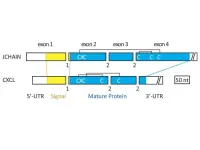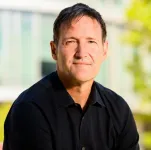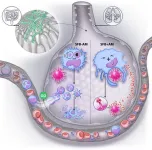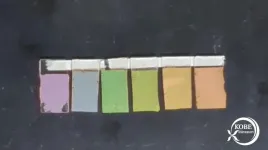(Press-News.org) Although the interior of São Paulo state (Brazil) has higher human development indices (HDIs) and fewer Black people as a percentage of the population, they account for a larger proportion of deaths from cancer in the Barretos region than in São Paulo city, the state capital, according to a study supported by FAPESP. An article on the study is published in the journal Cancer Causes & Control.
In the 18 cities of the Barretos regional health district (RHD), the number of deaths from all types of cancer is 18% higher among Black people than among White people. The same is true for each of the six main cancer types. Although mortality rates for stomach, colorectal and lung cancer are similar among Black and White people, they are much higher for breast cancer (18%) and cervical cancer (63%) among Black people. In the case of prostate cancer, mortality is 51% higher among Black than White people in the Barretos RHD.
The study period was 2011-17, and the mortality data came from the SUS (Sistema Único de Saúde), Brazil’s national public health network, whose records include patients’ self-declared race or skin color. In both localities analyzed, lung cancer was the main cause of death from cancer among White, Black and Multiracial people (the latter being termed Pardos in censuses and other official datasets). Among descendants of Asians, it was colorectal cancer. More Black and Multiracial women died from cervical cancer than White women.
“In light of this country’s history, including slavery and its continuing consequences, such as more affluence and more access to healthcare for White people, these results were to be expected. The surprise was finding out that more White people than Black People die from cancer in São Paulo city,” said Adeylson Guimarães Ribeiro, first and corresponding author of the article. He is Deputy Director of Information and Epidemiology at the São Paulo Cancer Center (FOSP), an arm of the São Paulo State Health Department.
Mortality is 19% higher among White than Black people in São Paulo city for all types of cancer and for breast cancer, 35% higher for lung cancer and 41% for colorectal cancer.
Ribeiro led the study while he was a postdoctoral research fellow at the International Agency for Research on Cancer (IARC) in France, under the supervision of Freddie Bray, Head of IARC’s Cancer Surveillance Section. The period abroad was part of Ribeiro’s postdoctoral internship at Hospital de Amor’s Institute of Education and Research with a scholarship from FAPESP. This institution was formerly known as the Barretos Cancer Hospital.
A previous study by the same group, without information on skin color or race, found high incidence and mortality rates for breast, colorectal and lung cancer among the most affluent inhabitants of São Paulo city. The finding can be correlated with the higher mortality rates for these types of cancer among White people compared with Black people reported in the more recent study.
The studies were part of the Thematic Project “Malignant neoplasms of the 18 cities of Barretos regional health district (RHD), São Paulo, Brazil: the importance of a population-based cancer registry”, supported by FAPESP and led by José Humberto Tavares Guerreiro Fregnani, a senior scientist at Hospital de Amor and a co-author of both articles.
The researchers aim to discover why the inequalities occur and how access to diagnosis and treatment can be guaranteed for everyone, among other goals.
Results aligned
Ancestry may account for some of the higher incidence rates for certain types of cancer, reinforcing the need for more attention to groups of the population that are particularly vulnerable owing to genetic and/or socioeconomic factors (read more at: linkinghub.elsevier.com/retrieve/pii/S1526820923000861).
The results described in the most recently published article are aligned with those of other Brazilian studies, such as the findings reported in an article signed by researchers at the State University of Campinas (UNICAMP). That study, which was also supported by FAPESP, showed higher mortality from breast cancer among White women than Black women in São Paulo state. However, it also showed that mortality was falling among White women and rising among Black women.
Another study found breast cancer survival rates among Black and Multiracial women to be lower, and yet another revealed a tendency for this type of cancer to be diagnosed at a late stage among Black and Multiracial women. All these results are aligned with the latest findings for Black women in the Barretos RHD.
An analysis of the determinants of late-stage diagnosis of cervical cancer pointed to a 20% higher risk of detection of this type of tumor at an advanced stage for Black women than for other ethnic groups.
With regard to prostate cancer, a 2013 study indicated a 300% higher risk of metastasis at the time of diagnosis for Black men.
“Few studies on this topic have been conducted in Brazil, but we have the information we need to do more research. In Europe, personal details on skin color or race are considered sensitive and aren’t available. The most numerous studies in the literature focus on the population of the United States, and their results are consistent with what we find here,” Ribeiro said.
About São Paulo Research Foundation (FAPESP)
The São Paulo Research Foundation (FAPESP) is a public institution with the mission of supporting scientific research in all fields of knowledge by awarding scholarships, fellowships and grants to investigators linked with higher education and research institutions in the State of São Paulo, Brazil. FAPESP is aware that the very best research can only be done by working with the best researchers internationally. Therefore, it has established partnerships with funding agencies, higher education, private companies, and research organizations in other countries known for the quality of their research and has been encouraging scientists funded by its grants to further develop their international collaboration. You can learn more about FAPESP at www.fapesp.br/en and visit FAPESP news agency at www.agencia.fapesp.br/en to keep updated with the latest scientific breakthroughs FAPESP helps achieve through its many programs, awards and research centers. You may also subscribe to FAPESP news agency at http://agencia.fapesp.br/subscribe.
END
Ethnic disparities in cancer mortality in the capital and northeast of the State of São Paulo, Brazil
In 18 cities of the Barretos region, where the proportion of Black people in the population is smaller, cancer kills more members of this ethnic group, whereas in the capital of the same state, it kills more White people
2024-01-30
ELSE PRESS RELEASES FROM THIS DATE:
Evolutionary origin of mysterious immune system molecule in humans revealed
2024-01-30
UNIVERSITY PARK, Pa. — Biological systems can behave as siblings in several ways, including by borrowing something and never giving it back. That appears to be what the human immune system did with a protein that now helps bind and regulate the subunits that make up antibodies, according to a multi-institute research collaboration. They found that, before the immune system evolutionarily co-opted it, the protein originally belonged to gene family responsible for directing cells to move to the right location at the right time to address specific functional needs.
The researchers, including Kazuhiko Kawasaki, associate research professor of ...
UCSF scientist wins Barancik Prize for Innovation in MS Research
2024-01-30
[New York, January 30, 2024] – Sergio E. Baranzini, PhD, a geneticist, neuroimmunologist and data scientist at the University of California, San Francisco, is the winner of this year’s Barancik Prize for Innovation in MS Research. Dr. Baranzini is being recognized for his pioneering efforts to integrate vast pools of information to understand complex mechanisms that cause MS and to develop more precise approaches to stop the disease and end it by prevention.
Baranzini is a Distinguished Professor and holds the Heidrich Friends and Family endowed chair in Neurology at the University of California, San Francisco ...
Salk Professor Joanne Chory honored with Benjamin Franklin Medal in Life Science
2024-01-30
LA JOLLA (January 30, 2024)—Salk Institute Professor Joanne Chory has been selected by the Franklin Institute in Philadelphia to receive a Benjamin Franklin Medal in Life Science for her achievements in plant science. She will receive a 14-karat gold medal and a $10,000 honorarium at the Franklin Institute Awards Ceremony in April 2024. Chory joins other extraordinary scientists and engineers as a Franklin laureate, including Nikola Tesla, Marie and Pierre Curie, Thomas Edison, Albert Einstein, and Jane Goodall, among others.
“Joanne’s contributions to the field of plant biology have impacted and will continue to impact scientists around the world,” ...
Study finds gut microbiota influence severity of respiratory viral infection
2024-01-30
The composition of microbiota found in the gut influences how susceptible mice are to respiratory virus infections and the severity of these infections, according to researchers from the Center for Translational Antiviral Research in the Institute for Biomedical Sciences at Georgia State University.
The findings, published in the journal Cell Host & Microbe, report that segmented filamentous bacteria, a bacterial species found in the intestines, protected mice ...
Smartphone-based shopping mall walking program and daily walking steps
2024-01-30
About The Study: This study found that the use of a smartphone-based mall walking program combined with physical shopping mall facilities and lottery-based digital incentive coupons may motivate people to increase their daily number of walking steps.
Authors: Masamichi Hanazato, Ph.D., of Chiba University in Chiba-shi, Chiba, Japan, is the corresponding author.
To access the embargoed study: Visit our For The Media website at this link https://media.jamanetwork.com/
(doi: 10.1001/jamanetworkopen.2023.53957)
Editor’s ...
Comparison of sleeve gastrectomy vs Roux-en-Y gastric bypass
2024-01-30
About The Study: This randomized clinical trial of 1,735 patients undergoing primary bariatric surgery found that both laparoscopic sleeve gastrectomy and laparoscopic Roux-en-Y gastric bypass were performed with a low perioperative risk without clinically significant differences between groups.
Authors: Suzanne Hedberg, M.D., Ph.D., of the University of Gothenburg in Gothenburg, Sweden is the corresponding author.
To access the embargoed study: Visit our For The Media website at this link https://media.jamanetwork.com/
(doi: 10.1001/jamanetworkopen.2023.53141)
Editor’s Note: Please see the article for additional information, including ...
Worries about costs, time off work and COVID-19 kept some older adults from having surgery
2024-01-30
When it comes to having surgery, older adults don’t just base their decision on how much pain they’ll feel and how quickly they’ll recover, a new study finds.
Many also have serious concerns about how much they’ll have to pay out of their own pockets, how much work they’ll miss, and whether they’ll catch COVID-19 in the hospital or surgery center.
And a majority of those who called themselves very concerned about these issues ended up not having an operation that they had considered having, the study finds. The percentage who didn’t go through with surgery was much lower among those who said they’d been very concerned about pain or the ...
JMIR Perioperative Medicine invites submissions on perioperative blood management
2024-01-30
JMIR Publications is pleased to announce a new theme issue titled “Perioperative Blood Management” in JMIR Perioperative Medicine. The premier, peer-reviewed journal is indexed in PubMed and focuses on how technology and data science can improve care delivery and surgical patient outcomes. The new theme issue aims to explore the latest advancements, challenges, and patient-centered innovative approaches in optimizing blood-related practices before, during, and after surgical procedures.
JMIR Perioperative Medicine welcomes contributions from global researchers, clinicians, and experts in ...
Structural color ink: Printable, non-iridescent and lightweight
2024-01-30
A new way of creating color uses the scattering of light of specific wavelengths around tiny, almost perfectly round silicon crystals. This Kobe University development enables non-fading structural colors that do not depend on the viewing angle and can be printed. The material has a low environmental and biological impact and can be applied extremely thinly, promising significant weight improvements over conventional paints.
An object has color when light of a specific wavelength is reflected. With traditional pigments, this happens by molecules absorbing other colors from white light, but over time this interaction makes the molecules degrade and the color fades. ...
A faster, more efficient imaging system for nanoparticles
2024-01-30
Teams led by professors Jinyang Liang and Fiorenzo Vetrone from the Énergie Matériaux Télécommunications Research Centre at the Institut national de la recherche scientifique (INRS) have developed a new system for imaging nanoparticles. It consists of a high-precision, short-wave infrared imaging technique capable of capturing the photoluminescence lifetimes of rare-earth doped nanoparticles in the micro- to millisecond range.
This groundbreaking discovery, which was published in the journal Advanced Science, paves the way for promising applications, particularly in the biomedical and information security fields.
Rare-earth ...
LAST 30 PRESS RELEASES:
Can community awareness campaigns in low-resource areas improve early diagnosis of colorectal cancer?
Stardust study resets how life’s atoms spread through space
Practical education: Clinical scenario-based program development
The impact of family dynamics on eating behaviour – how going home for Christmas can change how you eat
Tracing the quick synthesis of an industrially important catalyst
New software sheds light on cancer’s hidden genetic networks
UT Health San Antonio awarded $3 million in CPRIT grants to bolster cancer research and prevention efforts in South Texas
Third symposium spotlights global challenge of new contaminants in China’s fight against pollution
From straw to soil harmony: International team reveals how biochar supercharges carbon-smart farming
Myeloma: How AI is redrawing the map of cancer care
Manhattan E. Charurat, Ph.D., MHS invested as the Homer and Martha Gudelsky Distinguished Professor in Medicine at the University of Maryland School of Medicine
Insilico Medicine’s Pharma.AI Q4 Winter Launch Recap: Revolutionizing drug discovery with cutting-edge AI innovations, accelerating the path to pharmaceutical superintelligence
Nanoplastics have diet-dependent impacts on digestive system health
Brain neuron death occurs throughout life and increases with age, a natural human protein drug may halt neuron death in Alzheimer’s disease
SPIE and CLP announce the recipients of the 2025 Advanced Photonics Young Innovator Award
Lessons from the Caldor Fire’s Christmas Valley ‘Miracle’
Ant societies rose by trading individual protection for collective power
Research reveals how ancient viral DNA shapes early embryonic development
A molecular gatekeeper that controls protein synthesis
New ‘cloaking device’ concept to shield sensitive tech from magnetic fields
Researchers show impact of mountain building and climate change on alpine biodiversity
Study models the transition from Neanderthals to modern humans in Europe
University of Phoenix College of Doctoral Studies releases white paper on AI-driven skilling to reduce burnout and restore worker autonomy
AIs fail at the game of visual “telephone”
The levers for a sustainable food system
Potential changes in US homelessness by ending federal support for housing first programs
Vulnerability of large language models to prompt injection when providing medical advice
Researchers develop new system for high-energy-density, long-life, multi-electron transfer bromine-based flow batteries
Ending federal support for housing first programs could increase U.S. homelessness by 5% in one year, new JAMA study finds
New research uncovers molecular ‘safety switch’ shielding cancers from immune attack
[Press-News.org] Ethnic disparities in cancer mortality in the capital and northeast of the State of São Paulo, BrazilIn 18 cities of the Barretos region, where the proportion of Black people in the population is smaller, cancer kills more members of this ethnic group, whereas in the capital of the same state, it kills more White people








